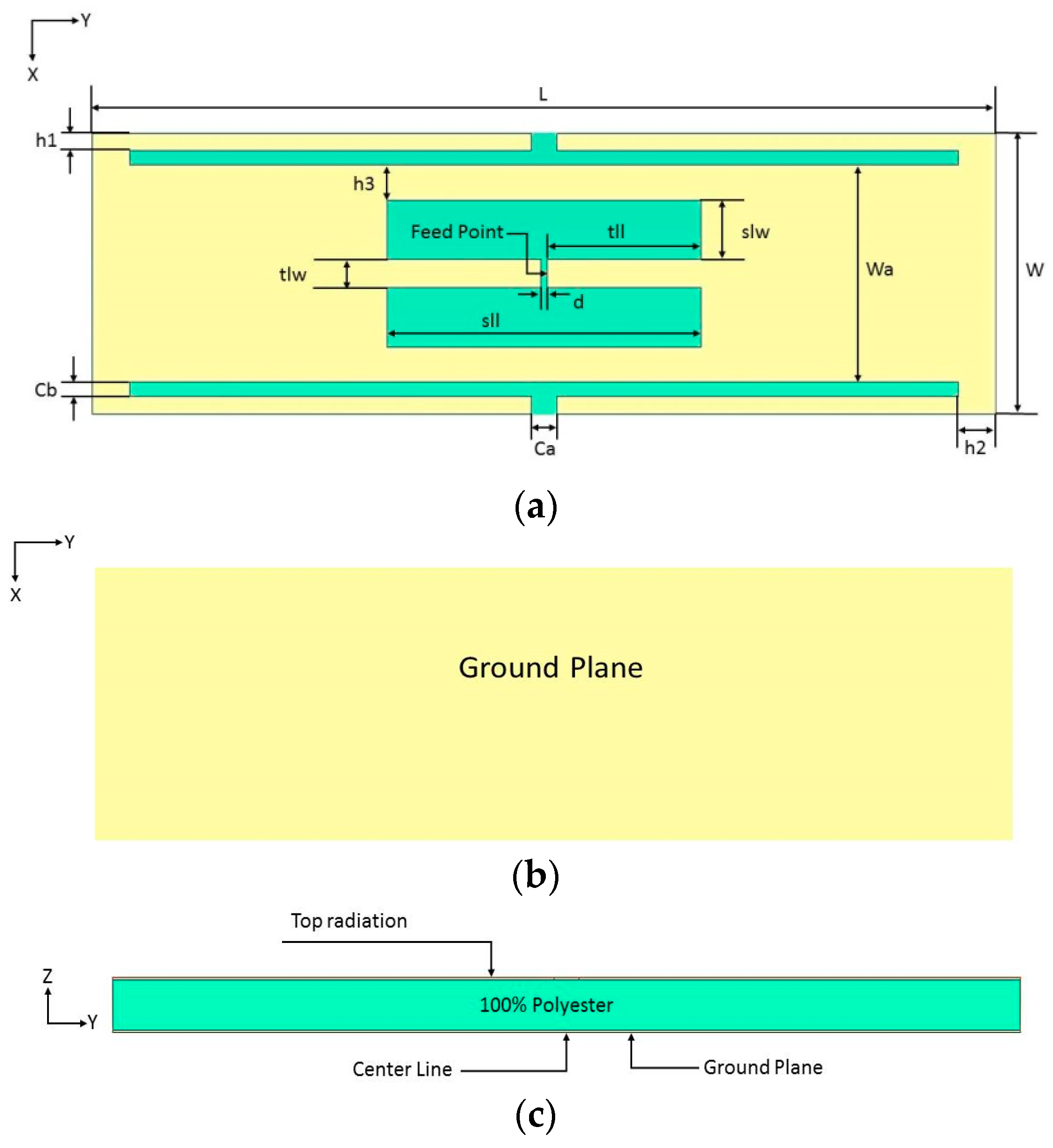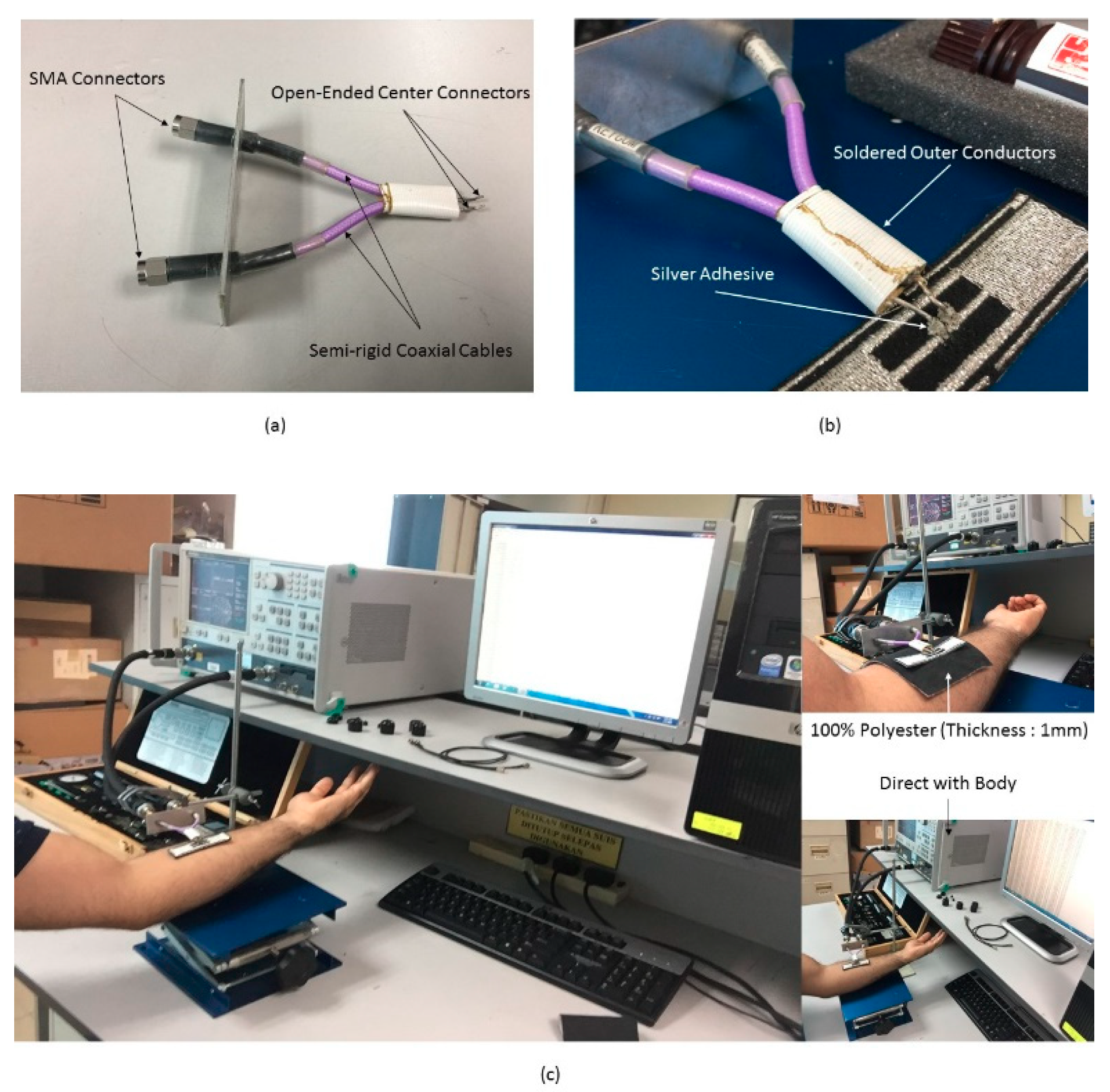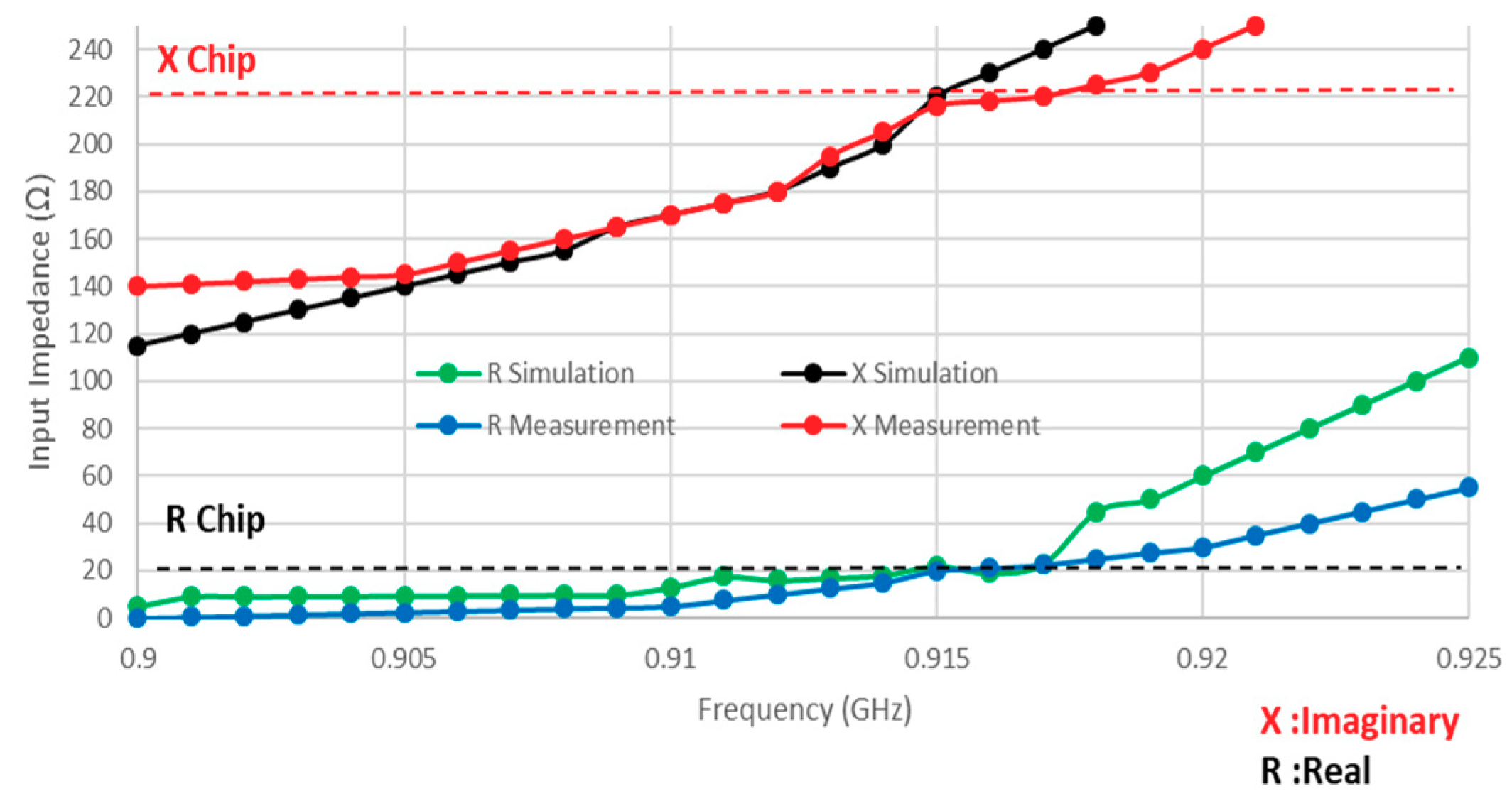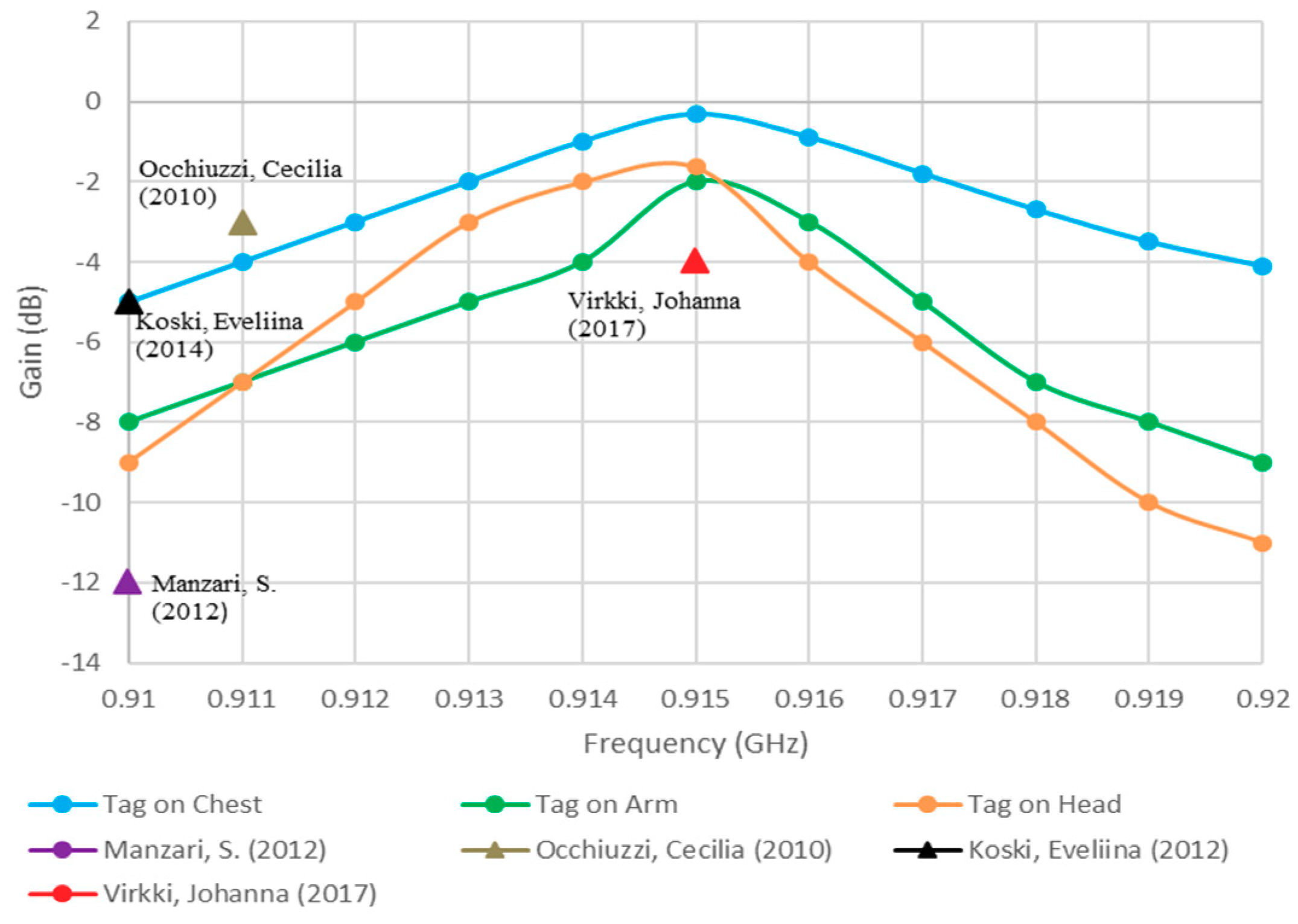Full Embroidery Designed Electro-Textile Wearable Tag Antenna for WBAN Application
Abstract
:1. Introduction
2. Antenna Design and Parametric Study
3. Measurements and Results
4. Conclusions
Author Contributions
Funding
Conflicts of Interest
References
- Virkki, J.; Wei, Z.; Liu, A.; Ukkonen, L. Wearable Passive E-Textile UHF RFID Tag based on a Slotted Patch Antenna with Sewn Ground and Microchip Interconnections. Int. J. Antennas Propag. 2017, 2017, 27–29. [Google Scholar]
- Yan, S.; Poffelie, L.A.Y.; Soh, P.J.; Zheng, X.; Vandenbosch, G.A.E. On-body performance of wearable UWB textile antenna with full ground plane. In Proceedings of the 2016 10th European Conference on Antennas and Propagation (EuCAP), Davos, Switzerland, 10–15 April 2016; pp. 28–31. [Google Scholar]
- Stanley-Marbell, P.; Marculescu, D.; Marculescu, R.; Khosla, P.K. Modeling, analysis, and self-management of electronic textiles. IEEE Trans. Comput. 2003, 52, 996–1010. [Google Scholar] [CrossRef]
- Koski, K.; Member, S.; Sydänheimo, L.; Fellow, L. Fundamental Characteristics of Electro-Textiles in Wearable UHF RFID Patch Antennas for Body-Centric Sensing Systems. IEEE Trans. Antennas Propag. 2014, 62, 6454–6462. [Google Scholar] [CrossRef]
- Ginestet, G.; Brechet, N.; Torres, J.; Moradi, E.; Ukkonen, L.; Björninen, T.; Virkki, J. Embroidered Antenna-Microchip Interconnections and Contour Antennas in Passive UHF RFID Textile Tags. IEEE Antennas Wirel. Propag. Lett. 2016, 16, 1205–1208. [Google Scholar] [CrossRef] [Green Version]
- Tsolis, A.; Whittow, W.; Alexandridis, A.; Vardaxoglou, J. Embroidery and Related Manufacturing Techniques for Wearable Antennas: Challenges and Opportunities. Electronics 2014, 3, 314–338. [Google Scholar] [CrossRef] [Green Version]
- Kellomaki, T. Effects of the Human Body on Single-Layer Wearable Antennas; Tampere University of Technology: Tampere, Finland, 2012; ISBN 9789521527784. [Google Scholar]
- Koski, K. Characterization and Design Methodologies for Wearable Passive UHF RFID Tag Antennas for Wireless Body-Centric Systems; Tampere University of Technology: Tampere, Finland, 2015; ISBN 9789521534348. [Google Scholar]
- Corchia, L.; Monti, G.; De Benedetto, E.; Tarricone, L. Wearable Antennas for Remote Health Care Monitoring Systems. Int. J. Antennas Propag. 2017, 2017, 3012341. [Google Scholar] [CrossRef]
- CST - Computer Simulation Technology. Available online: https://www.cst.com (accessed on 1 September 2015).
- Lesnikowski, J. Dielectric Permittivity Measurement Methods of Textile Substrate of Textile Transmission Lines. Electr. Rev. 2012, 88, 148–151. [Google Scholar]
- Kraus, J. Antennas, 2nd ed.; McGraw Hill: New York, NY, USA, 1988; p. 892. [Google Scholar]
- Sorrentino, R.; Bianchi, G. Microwave and RF Engineering; John Wiley & Sons, Ltd.: Hoboken, NJ, USA, 2010; ISBN 9780470758625. [Google Scholar]
- Park, J.H.; Seol, J.A.; Oh, Y.H. Design and implementation of an effective mobile healthcare system using mobile and RFID technology. In Proceedings of the 7th International Workshop on Enterprise networking and Computing in Healthcare Industry, Busan, Korea, 23–25 June 2005; pp. 263–266. [Google Scholar]
- Patron, D.; Mongan, W.; Kurzweg, T.P.; Fontecchio, A.; Dion, G.; Anday, E.K.; Dandekar, K.R. On the Use of Knitted Antennas and Inductively Coupled RFID Tags for Wearable Applications. IEEE Trans. Biomed. Circuits Syst. 2016, 10, 1047–1057. [Google Scholar] [CrossRef] [PubMed]
- Daniel, J.P. Transmission line analysis of nonlinear slot coupled microstrip antenna. Electron. Lett. 1992, 28, 15–17. [Google Scholar]
- Body Tissue Dielectric Parameters. Available online: https://www.fcc.gov/general/body-tissue-dielectric-parameters (accessed on 10 April 2016).
- Agsis—Syscom Advanced Materials. Available online: http://www.metalcladfibers.com/agsis (accessed on 20 July 2016).
- Zhu, H.; Ko, Y.C.A.; Ye, T.T. Impedance measurement for balanced UHF RFID tag antennas. In Proceedings of the 2010 IEEE Radio and Wireless Symposium (RWS), New Orleans, LA, USA, 10–14 January 2010; pp. 128–131. [Google Scholar]
- Tajima Group Official Site - Multi-head Embroidery Machine. Available online: http://www.tajima.com (accessed on 10 March 2017).
- Monti, G.; Corchia, L.; Tarricone, L. Fabrication techniques for wearable antennas. In Proceedings of the 2013 European Microwave Conference, Nuremberg, Germany, 6–10 October 2013; pp. 435–438. [Google Scholar]
- Kiourti, A.; Volakis, J.L. Colorful Textile Antennas Integrated into Embroidered Logos. J. Sens. Actuator Netw. 2015, 4, 371–377. [Google Scholar] [CrossRef]
- Rao, K.V.S.; Nikitin, P.V.; Lam, S.F. Impedance matching concepts in RFID transponder design. In Proceedings of the Fourth IEEE Workshop on Automatic Identification Advanced Technologies, Buffalo, NY, USA, 17–18 October 2005; pp. 39–42. [Google Scholar]
- Nikitin, P.V.; Rao, K.V.S.; Lam, S.F.; Pillai, V.; Martinez, R.; Heinrich, H. Power reflection coefficient analysis for complex impedances in RFID tag design. IEEE Trans. Microw. Theory Tech. 2005, 53, 2721–2725. [Google Scholar] [CrossRef]
- Jalal, A.S.A.; Ismail, A.; Alhawari, A.R.H.; Rasid, M.F.A.; Noordin, N.K.; Mahdi, M.A. Miniaturized Metal Mount Minkowski Frac- Tal Rfid Tag Antenna with Complementary Split Ring Resonator. Prog. Electromagn. Res. C 2013, 39, 25–36. [Google Scholar] [CrossRef]
- GAO Tek All-in-One Long Range UHF Gen2 Reader/Writer. Available online: https://gaotek.com/product/one-long-range-uhf-gen2-readerwriter/ (accessed on 15 May 2017).
- Occhiuzzi, C.; Cippitelli, S.; Marrocco, G. Modeling, Design and Experimentation of Wearable RFID Sensor Tag. IEEE Trans. Antennas Propag. 2010, 58, 2490–2498. [Google Scholar] [CrossRef] [Green Version]












| Parameters | Dimensions (mm) |
|---|---|
| Antenna side length (L) | 74 |
| Antenna side width (W) | 20 |
| Internal side width (Wa) | 15.5 |
| Slotted width (slw) | 4.25 |
| Slotted length (sll) | 25 |
| Transmission line length (tll) | 12.25 |
| Transmission line width (tlw) | 2 |
| Feed point (d) | 0.49 |
| The cut between outer line (Ca) | 2 |
| The cut line (Cb) | 1 |
| The outer line width (h1) | 1 |
| The distance between the cut and side edge (h2) | 4 |
| The distance between the cut (h3) | 2.5 |
| Reference | Dimensions (λeff3) | Substrate | Patch & GP | Reading Distance (m) |
|---|---|---|---|---|
| [1] | 0.22 × 0.12 × 0.015 | Flexible | Textile | 3–4 |
| [4] | 0.5 × 0.3 × 0.01 | Flexible | Textile | 3.9 |
| [8] | 0.37 × 0.25 × 0.016 | Flexible | Copper | 2.1 |
| [27] | 0.51 × 0.07 × 0.0005 | Flexible | Copper | 2.5 |
| Proposed Tag | 0.28 × 0.08 × 0.011 | Textile | Textile | 3.8 |
© 2019 by the authors. Licensee MDPI, Basel, Switzerland. This article is an open access article distributed under the terms and conditions of the Creative Commons Attribution (CC BY) license (http://creativecommons.org/licenses/by/4.0/).
Share and Cite
Abbas, B.; K. Khamas, S.; Ismail, A.; Sali, A. Full Embroidery Designed Electro-Textile Wearable Tag Antenna for WBAN Application. Sensors 2019, 19, 2470. https://doi.org/10.3390/s19112470
Abbas B, K. Khamas S, Ismail A, Sali A. Full Embroidery Designed Electro-Textile Wearable Tag Antenna for WBAN Application. Sensors. 2019; 19(11):2470. https://doi.org/10.3390/s19112470
Chicago/Turabian StyleAbbas, Bahaa, Salam K. Khamas, Alyani Ismail, and Aduwati Sali. 2019. "Full Embroidery Designed Electro-Textile Wearable Tag Antenna for WBAN Application" Sensors 19, no. 11: 2470. https://doi.org/10.3390/s19112470
APA StyleAbbas, B., K. Khamas, S., Ismail, A., & Sali, A. (2019). Full Embroidery Designed Electro-Textile Wearable Tag Antenna for WBAN Application. Sensors, 19(11), 2470. https://doi.org/10.3390/s19112470






